

Pula travel guide. Zlatna vrata Pula (Italian Pola, Slovene Pulj) is a nice town at the tip of the Istrian peninsula, Croatia.
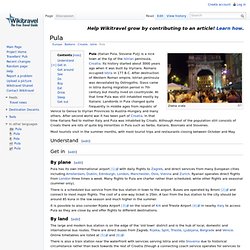
Its history started about 3000 years ago when it was built by Illyrians. Romans occupied Istria in 177 B.C. After destruction of Western Roman empire, Istrian peninsula was devastated by Ostrogoths. Slavs came in Istria during migration period in 7th century but mostly lived on countryside. Most tourists visit in the summer months, with most tourist trips and restaurants closing between October and May. Umag travel guide. Umag is a town in Istria on the Adriatic coast of Croatia.
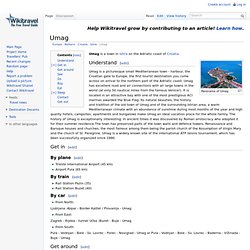
Panorama of Umag Understand[edit] Umag is a picturesque small Mediterranean town - harbour, the Croatian gate to Europe, the first tourist destination you come across on arrival to the northern part of the Adriatic coast. Umag has excellent road and air connections with all large towns in the world (at only 50 nautical miles from the famous Venice!). Istria travel guide. [Istria][1] (Croatian: Istra) is the north-westernmost region of Croatia.
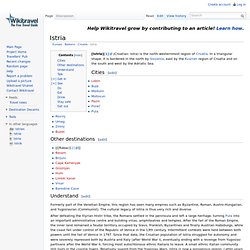
In a triangular shape, it is bordered in the north by Slovenia, east by the Kvarner region of Croatia and on the south and west by the Adriatic Sea. Cities[edit] Other destinations[edit] Understand[edit] Formerly part of the Venetian Empire, this region has seen many empires such as Byzantine, Roman, Austro-Hungarian, and Yugoslavian (Communist). Istria. Istria: Croatia in shades of blue and green. The beautiful town of Rovinj The peninsula boasts a rich monumental and cultural heritage The largest of the Adriatic peninsulas seems to comprise two different worlds.

One is the blue Istria with over 500 kilometres of coastline where pleasant rocky beaches are lapped by clear water; here you'll find little ports and picturesque towns like Rovinj, where the fishing tradition has its roots firmly in the past, as well as modern marinas where fashionable yachts lie at anchor. Farther inland lies the other Istria, where medieval towns sit on green hillsides in a landscape of cypresses, vineyards and olive groves reminiscent of the patchwork beauty of Tuscany. Almost on the frontier with northern Italy, the peninsula boasts a wealth of first-class monuments that tell the tale of the numerous peoples who have made their homes here down through countless centuries.
Where to eat: Both the hotels San Rocco and Valsabbion also boast first-rate restaurants. Dalmatia travel guide. Dalmatia [1] is the southern coastal region of Croatia on the Adriatic Sea.
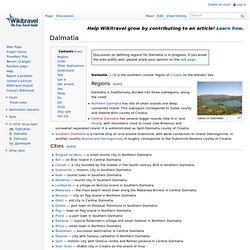
Lakes in Dalmatia Regions[edit] Explore Croatia's unspoiled Adriatic coastline. Sea organ. Sea organ in scaled form - the sound emerges from the holes along the top step The Sea organ (Croatian: Morske orgulje) is an architectural object located in Zadar, Croatia and an experimental musical instrument which plays music by way of sea waves and tubes located underneath a set of large marble steps.

History[edit] Chaotic reconstruction work was undertaken in an attempt to repair the devastation Zadar suffered in the Second World War. The frantic reconstruction turned much of the sea front into an unbroken, monotonous concrete wall. Sea Organ - Zadar, Croatia. The musical Sea Organ (morske orgulje) is located on the shores of Zadar, Croatia, and is the world’s first musical pipe organs that is played by the sea.

Simple and elegant steps, carved in white stone, were built on the quayside. Underneath, there are 35 musically tuned tubes with whistle openings on the sidewalk. The movement of the sea pushes air through, and – depending on the size and velocity of the wave – musical chords are played. The waves create random harmonic sounds. This masterpiece of acoustics and architecture was created by expert Dalmatian stone carvers and architect Nikola Basic in 2005, who recently received the European Prize for Urban Public Space for this project.
Zadar. Zadar travel guide. Zadar is a city located in northern Dalmatia, Croatia.
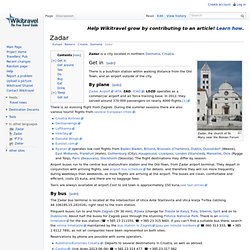
Zadar, the church of St. Mary near the Roman Forum Get in[edit] There is a bus/train station within walking distance from the Old Town, and an airport outside of the city. Dubrovnik travel guide. Dubrovnik Dubrovnik is a stunningly intact walled city on the Adriatic Sea coast of the extreme south of Croatia.
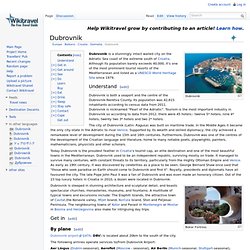
Although its population barely exceeds 40,000, it's one of the most prominent tourist resorts of the Mediterranean and listed as a UNESCO World Heritage Site since 1979. Dubrovnik Online. Croatia. Croatia. Croatia [1] (Croatian: Hrvatska) is a country situated in Southeast Europe.

It is to the east side of the Adriatic Sea, to the east of Italy. It is also bordered by Slovenia to the northwest, Hungary to the north, Bosnia and Herzegovina to the southeast, Serbia in the east, and Montenegro to the south. Understand[edit] Climate[edit] Northern Croatia has a temperate continental climate whereas the central and upland regions have a mountainous climate. Terrain[edit] Geographically diverse; flat agricultural plains along the Hungarian border (Central European area), low mountains and highlands near the Adriatic coastline and islands. World Heritage Sites. Central Croatia. Central Croatia (Croatian: Središnja Hrvatska) or Croatia proper is a historical region[1] of Croatia that encompasses territory around Zagreb, located between Slavonia in the east and the Adriatic Sea in the west. The region has no official definition, and its borders and extent are described differently by various sources. Zagreb travel guide. Ban Jelačić Square Zagreb [1] is a city in Central Croatia and the capital of Croatia.
Understand[edit] Zagreb is a vibrant city of around 800,000 people (metropolitan area: 1,200,000). The city boasts a charming medieval 'old city' with architecture and cobbled streets reminiscent of Vienna, Budapest, Prague and other Central-European capitals. In 2011 it was visited by over 700000 tourists, mainly from Austria, Germany and Italy. Karlovac travel guide. Karlovac is a city in the northwest Croatia, 45 km southwest of Zagreb with a population of approximately 60,000. Understand[edit] The town is located at the junction of 4 rivers is stunning. Almost everyone knows Karlovac as the city on four rivers.
Varaždin travel guide. Plitvička Jezera. Demographics[edit] According to 2001 census, its total population was 4,668. Plitvice Lakes National Park, Croatia. Plitvice Lakes National Park in Croatia. Plitvice, a watery paradise in Croatia. In recent years, Croatia has changed from a relative unknown to one of the trendiest destinations in Europe. Slavonia. Slavonia (Croatian: Slavonija) is a historical region[2] in eastern Croatia, roughly corresponding with five Croatian counties: Brod-Posavina, Osijek-Baranja, Požega-Slavonia, Virovitica-Podravina and Vukovar-Syrmia, although the territory of the counties includes Baranja, and the definition of the western extent of Slavonia as a region varies. The counties cover 12,556 square kilometres (4,848 square miles) or 22.2% of Croatia, inhabited by 806,192—18.8% of Croatia's population.
Vukovar travel guide. Turist board Vukovar. Vukovar. Franjo Tuđman Square. Baranja (region) Osijek-Baranja County. History[edit] Osijek-Baranja County was established in 1993. Administrative divisions[edit] Kopački Rit. Kopački Rit, a nature park in Baranja The Flora Kopački Rit (Kopački Tršćak, Hungarian: Kopácsi rét), is a nature park in eastern Croatia. Photos of Kopacki rit Nature Park, Croatia. Beli Manastir. Osijek travel guide. Croatia Briefly. CroaTour. Croatian National Tourist Board.